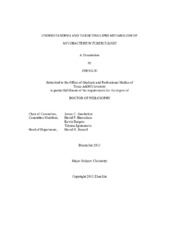| dc.description.abstract | Mycobacterium tuberculosis (M. tuberculosis) contains a wide array of genes responsible for the synthesis and secretion of a variety of bioactive lipids. The genes represent attractive drug-targets due to their involvement in essential cell cycles, the implication in pathogenesis, and the interference with therapeutics. In this thesis, I report our efforts to understand the biological functions of, and to develop inhibitors against, multiple genes related to M. tuberculosis lipid metabolism. Firstly, dioctylamine, a substrate mimic of the mycolic acid cyclopropane synthases, is shown to inhibit CmaA2 in vitro. Its inhibition action is explained by the structural characterization. Together with our collaborators, we have found dioctylamine able to intervene multiple mycolic acid cyclopropane synthases in vivo, and hence established the first model study for the single-drug-multiple-target strategy to inhibit the mycolic acid biosynthesis of M. tuberculosis. In addition, dioctylamine can serve as the platform for the design of more potent and selective drugs in the future. Secondly, the action mechanism of isoniazid and ethionamide, both of which are pro-drugs targeting the mycolic acid biosynthesis, is explored via biochemical, X-ray crystallographic or modeling studies. We have determined that the intracellular target of isoniazid is the enoyl reductase InhA; and we have discovered the correlation between mycothiol and ethionamide susceptibility. Thirdly, I have investigated the function and mechanism of FadD10, an enzyme involved in the synthesis of a virulence-related lipopeptide. The results reveal that FadD10 was mis-annotated as a fatty acyl-CoA ligase, but it indeed transfers fatty acids to an acyl carrier protein (Rv0100). Further crystallographic characterization provides the molecular basis for the mechanism of FadD10, leading to the discovery of a new type of adenylate-forming enzyme. | en |


